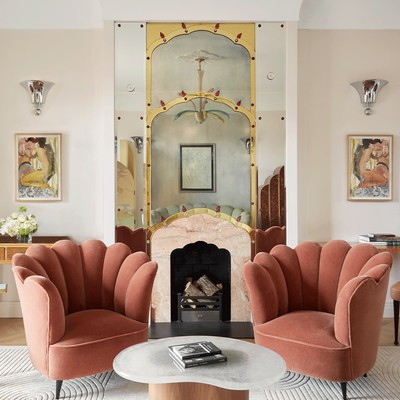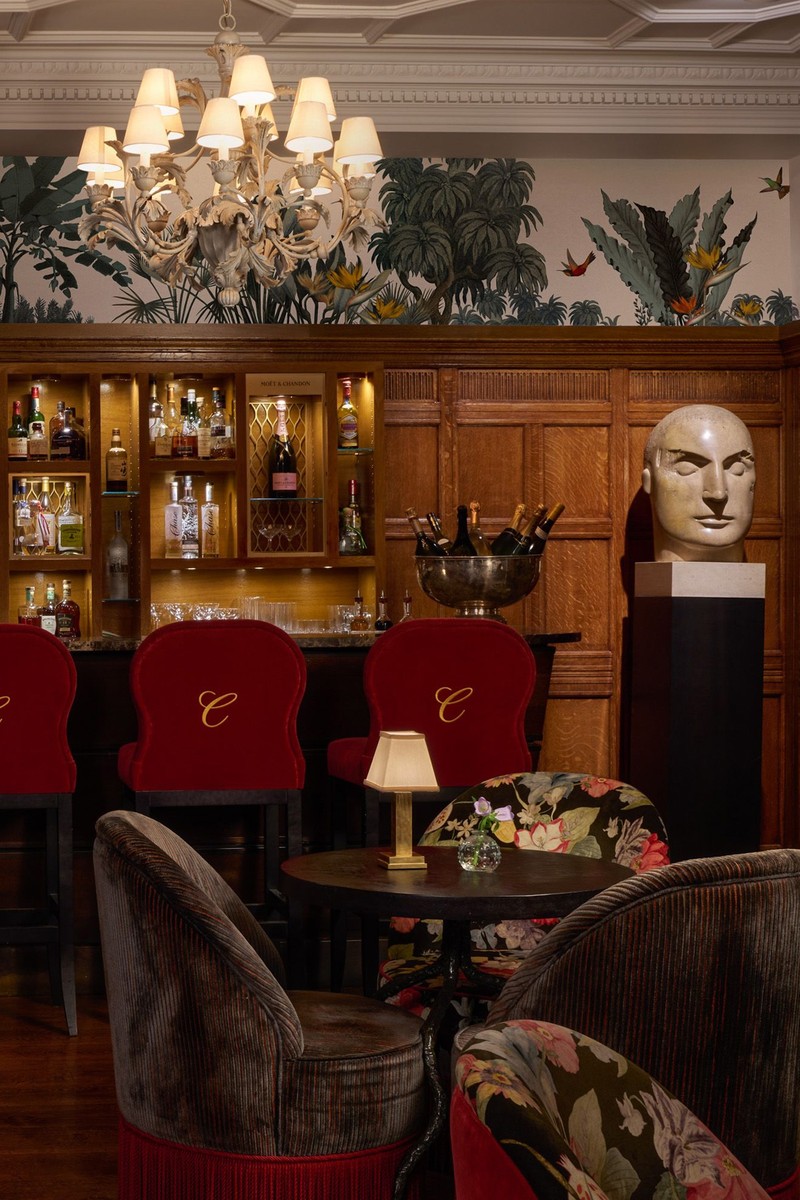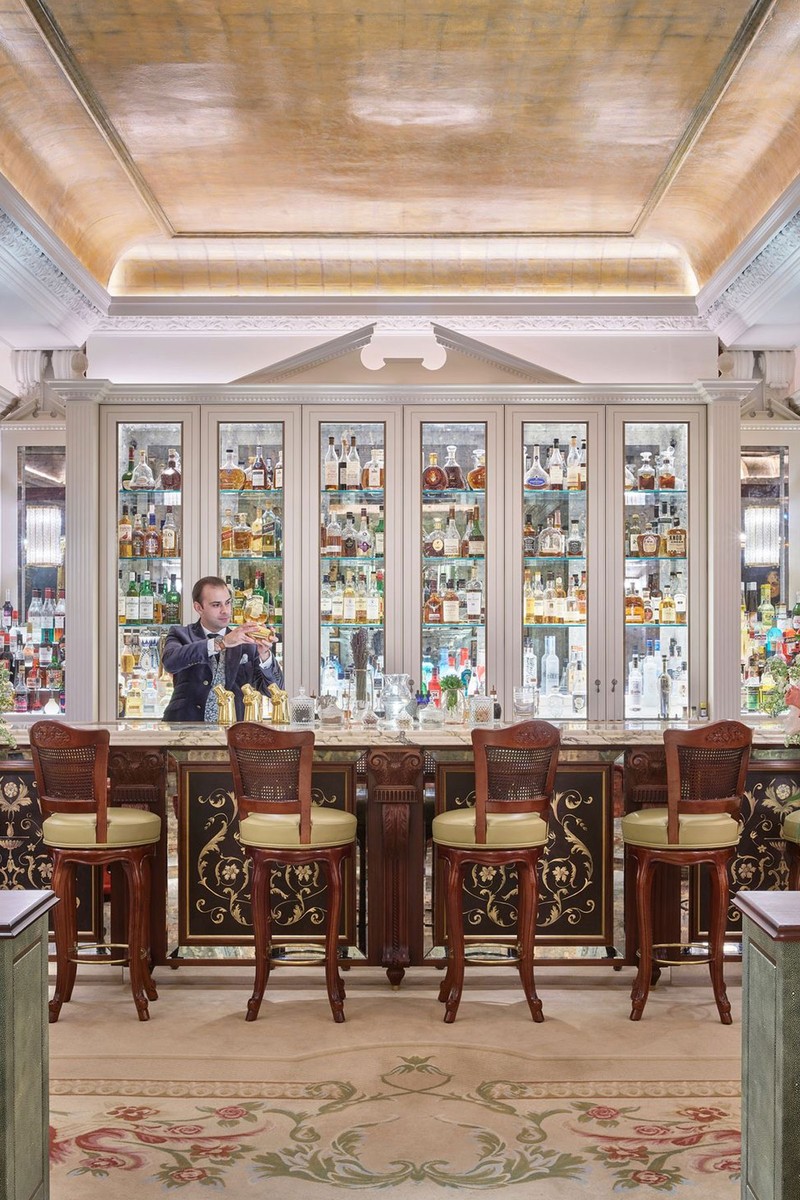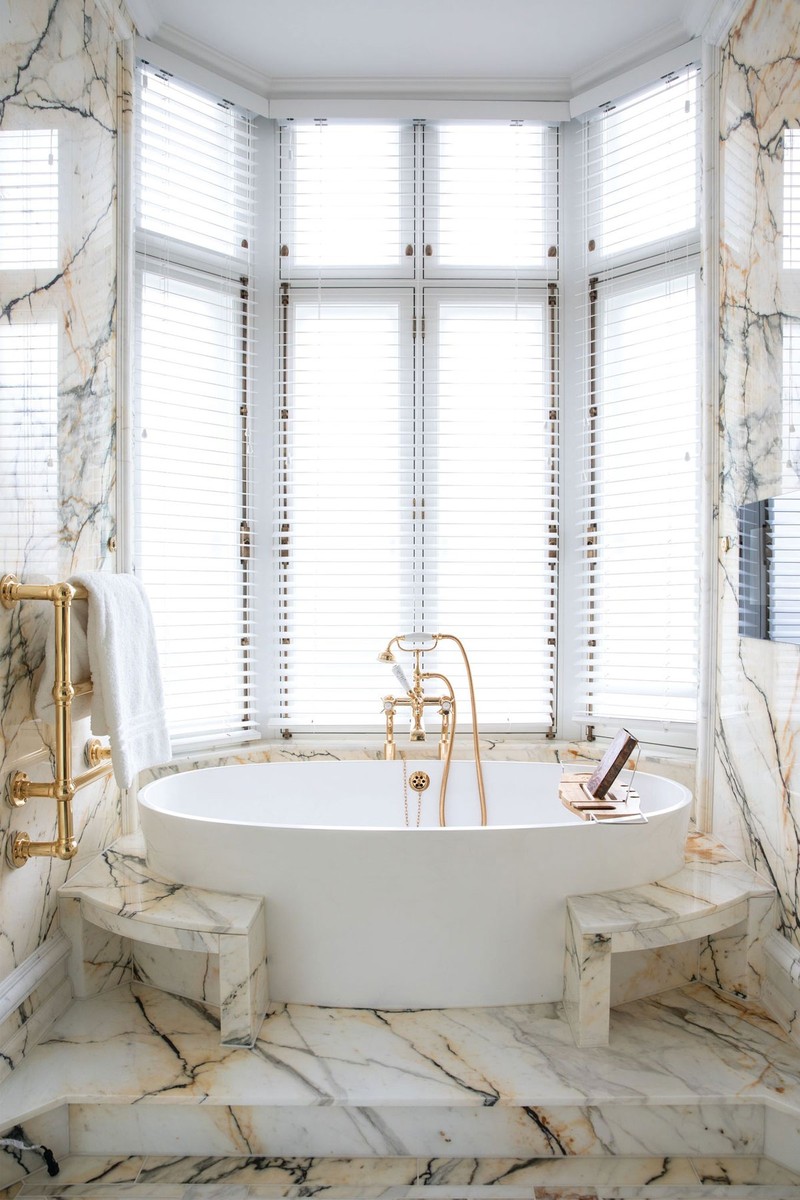
5 Iconic & Historic London Hotels
BROWN’S HOTEL
The History: Brown’s is said to be London’s first hotel. When it opened in 1837, it was run by James and Sarah Brown, a former valet and maid to Lord and Lady Byron. Since then, countless notable figures have crossed its threshold – from royalty and aristocrats to politicians, writers and artists. Napoleon III and Empress Eugenie stayed here to escape from France’s Third Republic; Queen Victoria often took tea in the tearoom; it’s where Alexander Graham Bell made his first London phone call in 1876; Teddy Roosevelt spent the night before his wedding here; it also became a favourite hangout for the who’s who of writers like Oscar Wilde, Robert Louis Stevenson, JM Barrie to name just a few, as well as Rudyard Kipling who wrote ‘The Jungle Book’ during one of his many stays. Other notable guests have included British prime ministers such as Anthony Eden and David Lloyd George, as well as Princess Elizabeth in 1951, the year before she became Queen Elizabeth. In 2003, Brown’s was taken over by Rocco Forte Hotels and closed to undergo a multi-pound refurb; it was reopened in late 2005 by Margaret Thatcher.
The Lowdown: In Mayfair, a stone’s throw from the Royal Academy, Burlington Arcade, Bond Street’s designer shops and the theatres on Shaftesbury Avenue, Brown’s is quintessentially British, offering all you would expect from a five-star hotel without any hint of stuffiness. From the porters in top hats and the helpful reception team as you enter to turn-down and everything in between, the attention to detail is impeccable and charming. The interiors by the group’s director of design (and Sir Rocco Forte’s sister) Olga Polizzi are super stylish – expect muted shades offset with pops of colour and unique artworks. We love the very English wallpaper by artist Adam Ellis that fills the entire ground floor – hand-painted blue and white cascades of wisteria populated with colourful native birds – and the stunningly ornate Venetian-style chandelier.
The Rooms: The hotel is made up of 11 townhouses merged into one property. There are 115 rooms and suites, all generous in size with a light, breezy feel – count on green velvet armchairs, leaf-themed wallpaper, queen-size beds, bookcases filled with historic novels, marble bathrooms with Irene Forte toiletries and fluffy bathrobes. For all-out luxury, the hotel’s premier Kipling Suite has a huge sitting room with floor-to-ceiling windows overlooking Albemarle Street, and is decked out in period features and antique furnishings with contemporary touches. From the quirky monkey statue outside the door to a framed handwritten letter from Kipling, there are nods to the author throughout.
Eating & Drinking: The menu at Charlie’s, which is overseen by Adam Byatt (from Trinity in Clapham), is recognisably British, using local produce to deliver classics like beef from the trolley and prawn cocktail with avocado and Marie Rose sauce – but with a modern twist. Other highlights include a Caesar salad like no other, crab with remoulade, calf’s liver and Dover sole. The maître d’ is celebrated Jesus Adorno, who presided over Le Caprice for nearly 40 years and welcomes guests old and new with all his usual charm and care. The room still has the original wood panelling, and Olga has recently revamped the décor with a tropical-looking wallpaper, and created smaller eating areas with semi-circular banquettes. Post dinner, head for a nightcap to the Donovan Bar, named after Terence Donovan, the famous English photographer of the 60s whose iconic black and white prints adorn the walls. The impressive cocktail menu comes courtesy of the great maestro Salvatore Calabrese, and is themed by author, actors and musicians, iconic people, iconic moments and more. The Drawing Room serves traditional afternoon tea – picture crimped sandwiches, dainty pastries and scones with fresh cream and jam. From 21st November you can enjoy a special Festive Tea.
For a bespoke musical evening, book a suite, order from Charlie’s menu and enjoy a private concert in your room – the hotel’s musical curator can arrange performances from string quartets, harpists, guitarists or, for the jazz enthusiast, there’s the hotel’s resident saxophonist.
Brown’s Hotel, 33 Albemarle Street, Mayfair, W1S 4BP
THE GORING
The History: The Goring is the only hotel in London that is still owned by the family that built it – four generations have run it since it was opened in 1910 by Otto Goring. The Edwardian baroque building was designed by the fashionable architect John Evelyn Trollope and was the first hotel in the world to offer central heating and a bathroom for every bedroom. While only dating back just over a century, the Goring deserves its place here on account of the many famous people who have stayed and the number of historic events that have taken place within its walls. The Commander of the American Expeditionary Forces was based at the hotel during the First World War; Winston Churchill held meetings with allied leaders in the Silver Room during the Second World War while the Polish army in exile was based upstairs. For a while, it was also home to Churchill’s mother, Lady Randolph Churchill, who would receive regular visits from her son. The hotel has also been a royal favourite since its beginnings and every reigning monarch has passed through the doors. In 1953, the coronation of Queen Elizabeth II saw a vast influx of foreign royalty come to stay. And, of course, Kate Middleton stayed in the Royal Suite the night before her wedding to Prince William in 2011.
The Lowdown: Set on a quiet, leafy street in Belgravia and impeccably English, the Goring is something of a hidden gem that feels off the beaten track, despite being a couple of minutes’ walk from Victoria station. As the closest luxury hotel to Buckingham Palace, the Queen Mother was a frequent visitor and Queen Elizabeth II used to host Christmas parties for senior members of her staff here, and awarded the hotel a Royal Warrant in 2013. A few years ago, the hotel underwent a head-to-toe renovation, closing for the first time in it is history, and four leading designers – Nina Campbell, Tim Gosling, David Linley and Russell Sage – redesigned every area. We love the front hall which is decked in hand-painted wallpaper depicting an English parkland into which wild animals have escaped (some of the animals represent members of the Goring family). And should you need any tips on what to do and where to go, head concierge ‘Big John’ knows London better than anyone else and can help organise your every wish – or almost!
The Rooms: The 69 rooms and suites, some with a private terrace, are individually designed in a timeless English classic theme, with wallpaper by Gainsborough (the silk weaving company in Suffolk), that is a replica of what’s in the White Drawing room in Buckingham Palace. The penthouse Royal Suite has a balcony that runs the entire length of the top floor, with large French windows in each of the rooms overlooking the hotel’s private garden.
Eating & Drinking: It would be a mistake not to book in for dinner at The Dining Room, an elegant room designed by David Linley, where you’ll be treated to first-class Michelin-starred food under Swarovski chandeliers . As a starter, the Queen Mother is known to have been partial to Eggs Drumkilbo, a lobster and egg-based dish that remains one of the most popular dishes. Other highlights include lobster omelette and beef Wellington, but do leave space for a pud, like the chocolate cremeux with Alphonso mango, passion fruit and sea salt, or some of the British cheeses served with wild honey. The cocktail bar is a lively destination with an excellent pianist. Here, you can enjoy one of the many signature classics, from the Rosehip Royale to the Goring Cup, made with liqueurs and spirits from fellow Royal Warrant holders and herbs from the hotel’s garden. If afternoon tea is more your thing, the hotel has been serving this English classic in the Veranda since it opened.
The Goring, 15 Beeston Place, Belgravia, SW1W 0JW
CLARIDGE’S
The History: Undoubtedly London’s grandest and most iconic hotel, Claridge’s began life humbly in 1812 when William and Mary Claridge started running a small hotel called Mivart's at 51 Brook Street in Mayfair, before buying adjoining buildings and officially opening as Claridge’s in 1856. After a redesign in the 1890s, the hotel soon became the place to dance into the small hours and this continued after the First World War when flappers, bobs and London’s bright things made Claridge’s their own and the ballroom echoed to the songs of Gershwin and the steps of the Charleston. A further redesign at the end of the 1920s gave the hotel its distinctive Art Deco features that remain today. A long list of famous visitors starts with Queen Victoria and Prince Albert in 1860, running through to Hollywood stars like Marlene Dietrich, Audrey Hepburn, Katharine Hepburn and Cary Grant – Spencer Tracy even said he’d rather go to Claridge’s than to heaven when he dies. During the Second World War, Claridge’s was home for many exiled royals, including the Queen of the Netherlands and the kings of Greece, Norway and Yugoslavia. Legend has it that Winston Churchill declared suite 212 Yugoslavian territory for one day during 1945, so the exiled Queen Alexandra could give birth to her son on Yugoslavian soil. In the 70s, fashion designer Diane von Furstenberg was commissioned to design some of the interiors at a time when guests included Aristotle and Jackie Onassis, as well as the Queen Mother who regularly lunched in the restaurant.
The Lowdown: In the heart of Mayfair on the corner of Brook Street and Davies Street, and close to the shops of Bond Street and Oxford Street, guests return here for the faultless service, excellent food and luxe rooms. There’s not an ounce of stuffiness despite its reputation as one of the best hotels in the world. At this time of the year, guests can look forward to Claridge’s Christmas tree which has been a festive Mayfair landmark and worth catching a glimpse of even if you are not staying. Details of this year’s are under wraps at the time of writing, but recent trees have been created by the likes of Christian Louboutin, Alber Elbaz for Lanvin, Dolce & Gabbana, Karl Lagerfeld and John Galliano for Dior. Until a month ago, the hotel hadn’t been big on its spa facilities with just a few treatments rooms at the top of the hotel. But now, in a project that has seen teams of experts excavate five floors out of the London clay, the hotel has its first ever spa, a haven of wellness and tranquillity featuring a swimming pool, steam rooms, sauna and seven treatments rooms.
The Rooms: Some of the largest in London, accommodation is divided into rooms, suites and signature suites, with some of the larger ones sleeping up to four. Each is quite unique and individually designed. Splash out on the Corner Suite which has high ceilings and large bay windows, and is furnished with a mix of Regency antiques and mid-century pieces. For all out luxury, go for one of the signature suites. Whatever your choice, every room is guaranteed to be uber comfortable and stylish.
Eating & Drinking: The Foyer & Reading Room, located off the lobby, is open for breakfast, lunch and dinner, and is probably one of the most popular London venues for afternoon tea. In the centre of the room a striking Chihuly sculpture hangs like a chandelier and the walls are decked in original Art Deco mirrors. The menu celebrates the freshest ingredients from land and sea, and includes classics like seafood cocktail with lobster, prawn and crab; Dover sole meunière with capers and parsley; and roasted loin of lamb, with artichoke, sweetbreads and maitake mushrooms. Last year, the hotel opened its third bar, The Painter’s Room, to sit alongside the dark and glamorous Fumoir and the iconic Claridge’s Bar. With just 24 covers, the newcomer’s name pays homage to its space which was created in the 30s with murals by renowned artist Mary Lea. The design by Bryan O’Sullivan pays tribute to the hotel’s Art Deco heritage and is inspired by old photos from the archives.
Claridge’s, Brook Street, Mayfair, W1K 4HR
THE CADOGAN
The History: Midway between Knightsbridge and Sloane Square, the Cadogan first opened at 75 Sloane Street, on the corner of Pont Street, in 1887. Over the course of its history, the hotel has hosted notable figures, the most famous being Oscar Wilde. At the time, Chelsea was where artists and authors gathered, and the Cadogan’s bar was where many of them met. Wilde lived with his wife and sons in nearby Tite Street but was a regular and often stayed overnight. While there were rumours circulating about his homosexuality (illegal at the time, of course) and his affair with the son of the Marquess of Queensbury, it wasn’t until he was arrested in his room in the hotel in 1895 that this was confirmed. His arrest became the subject of a 1930s poem by poet laureate John Betjeman, ‘The Arrest of Oscar Wilde at the Cadogan Hotel’. Another famous visitor was the actress and socialite Lillie Langtry, who lived next door at 21 Pont Street, and was said to have met her lover, the future King Edward VII, at the hotel. When she sold her house to the hotel, the agreement was that she could live there, and she used to stay overnight in room 109. Her front door is now a private entrance to the hotel, and her original mosaic floor and staircase remain unchanged.
The Lowdown: The management of the hotel was taken over by Belmond in 2014 and, after a massive refurb, it reopened in 2019. With Villa San Michele in Florence, Orient Express and Manoir aux Quat’Saisons in its portfolio, the group had long wanted a central London location. Today, it has transformed this collection of five buildings into a bright and airy space that is glamorous and modern, while retaining its heritage and period features. The location means it’s perfect for shopping in Harrods, Harvey Nichols, the designer boutiques of Sloane Street, as well as Peter Jones and the King’s Road in the opposite direction. Guests have access to the private gardens across the road. Once the London Botanic Garden in the 18th century, they are now home to tennis courts, sculptures and a 300-year-old mulberry tree.
The Rooms: By London five-star hotel standards, the Cadogan is small, with just five floors and 54 rooms, two-thirds of which are suites. All are individually designed with silk and velvet, pops of colour and original artworks by female artists – the vibe is homely modern elegance. Should you feel like splashing out, Oscar Wilde’s room 118 where he was arrested is now part of the Royal Suite.
Eating & Drinking: The LaLee restaurant pays homage to the life and travels of Lillie Langtry, and is named after her private railway carriage in which she travelled round Europe. It’s a buzzy, all-day Chelsea eaterie that attracts non-staying guests. You will find some classics on the menu such as steak tartare and Caesar salad, as well as schnitzels which are all served tableside. The cocktail menu is extensive, beginning with brunch and taking you through to aperitifs and post-dinner nightcaps. The negronis are a speciality but stick to just the one!
The Cadogan, 75 Sloane Street, Chelsea, SW1X 9SG
THE SAVOY
The History: The Savoy was opened by theatre impresario Richard D’Oyly Carte in 1889. He had already opened the Savoy Theatre next door in 1881 to showcase the popular Gilbert and Sullivan comic operas. It was the first purpose-built deluxe hotel in Britain and the first to be lit by electricity, with the first electric lifts – known as ‘ascending rooms’. Later, it became the first hotel to have private ensuite bathrooms with free-flowing hot water. D’Oyly Carte brought in the well-known hotel manager César Ritz to run his hotel and he in turn brought in the great chef Georges Auguste Escoffier. Escoffier reorganised the kitchen into ‘stations’ which revolutionised the restaurant industry in Britain and is how most large restaurant kitchens are still run to this day. From the start, the Savoy set new standards for luxury, comfort and service, fast becoming a magnet for the wealthy, famous and fashionable. Early guests included Sarah Bernhardt and Dame Nellie Melba for whom Escoffier created Melba toast and peaches Melba. Throughout the early 20th century the biggest stars loved staying here – from Marlene Dietrich, Cary Grant, Ava Gardner, Frank Sinatra, the Marx brothers, Laurel and Hardy and Bob Hope to Marilyn Monroe and Charlie Chaplin. Agatha Christie was also a frequent visitor to the hotel, which regularly hosted parties for the premieres of her plays.
As with the other ‘grandes dames’ in this article, the Savoy attracted royalty, most notably the Prince of Wales, later Edward VII, who frequently enjoyed dining here with his friends in the 1890s. In the 20th century, the royal family continued to visit – from Queen Mary to the Queen Mother, as well as the young princesses Elizabeth and Margaret who came for dinner and dancing in the 1940s, and Princess Diana. In 1946, the entire Royal Family attended a wedding reception of a distant relative of the Queen at the Savoy. Princess Elizabeth was chief bridesmaid and was snapped with a man in uniform – Prince Philip of Greece – to whom she was already engaged. The photograph was the first time their relationship came to public attention.
The Lowdown: The Savoy is as much a part of London as Big Ben, the Houses of Parliament and the Tower of London. On the Strand, it is ideally placed for the West End theatres and the Royal Opera House, as well as the National Theatre and Royal Festival Hall across the river. Museums like the National Gallery and the Courtauld are close by, or cross Waterloo Bridge to the Hayward and Tate Modern. The shops in Covent Garden are on its doorstep. Regular guests return year after year, and much of the hotel’s success lies in the staff. Some have worked here for over 30 years, witnessing the comings and goings of the many illustrious guests who have passed through the revolving doors, but never divulging any of their secrets.
The Rooms: The 267 rooms and suites are individually decorated in either elegant Edwardian or Art Deco style. Opt for one overlooking the Thames for unparalleled views (featured in some of Whistler’s and Monet’s works) and spectacular panoramas at night. Last year, the Royal Suite was redesigned in homage to Guccio Gucci. As a young man, he was employed at the Savoy as a luggage porter and liftboy. He soon saw the tastes and needs of the guests which gave him the impetus to start his own leather goods company when he returned to Italy. The suite now features furniture, furnishings and decorative items from the Gucci Décor collection, as well as art and antiques curated by Christie’s.
Eating & Drinking: The iconic American Bar opened in 1893 and is the longest surviving cocktail bar in London, as well as one of the most renowned. Serving all the classics, the bar has seen countless well-known faces from Winston Churchill to Ernest Hemingway. Note there is a walk-in only policy for non-guests. The jet-black and gold Beaufort Bar is uber glam and open Thursday to Saturday nights only, with a DJ playing. Gordon Ramsay heads up the kitchens where Escoffier once presided. Home to a century plus of Hollywood guests and royalty, the Savoy Grill offers a menu that’s British and French inspired – you’ll find classics like beef Wellington, grilled meats served from the wood-fired grill, as well as extensive fish choices. For a culinary journey, opt for the Taste of Savoy Grill tasting menu. The River Restaurant is in the heart of the hotel with views over the Thames. Here, the emphasis is on shellfish and seafood – from oysters, ceviche and caviar served from the raw bar to the a la carte menu where you’ll find tandoori monkfish curry, grilled lobster and whole dayboat fish. With a menu that pays homage to Escoffier, Restaurant 1890 opened earlier this year and seats just 26 guests in an intimate setting overlooking the iconic entrance to the hotel.
The Savoy, Strand, West End, WC2R 0EZ
DISCLAIMER: We endeavour to always credit the correct original source of every image we use. If you think a credit may be incorrect, please contact us at info@sheerluxe.com.


/https%3A%2F%2Fsheerluxe.com%2Fsites%2Fsheerluxe%2Ffiles%2Farticles%2F2022%2F10%2Flondon-hotels-3.jpg?itok=TV4RiWA9)


/https%3A%2F%2Fsheerluxe.com%2Fsites%2Fsheerluxe%2Ffiles%2Farticles%2F2022%2F10%2Flondon-hotels-4.jpg?itok=e0pFWXoJ)

